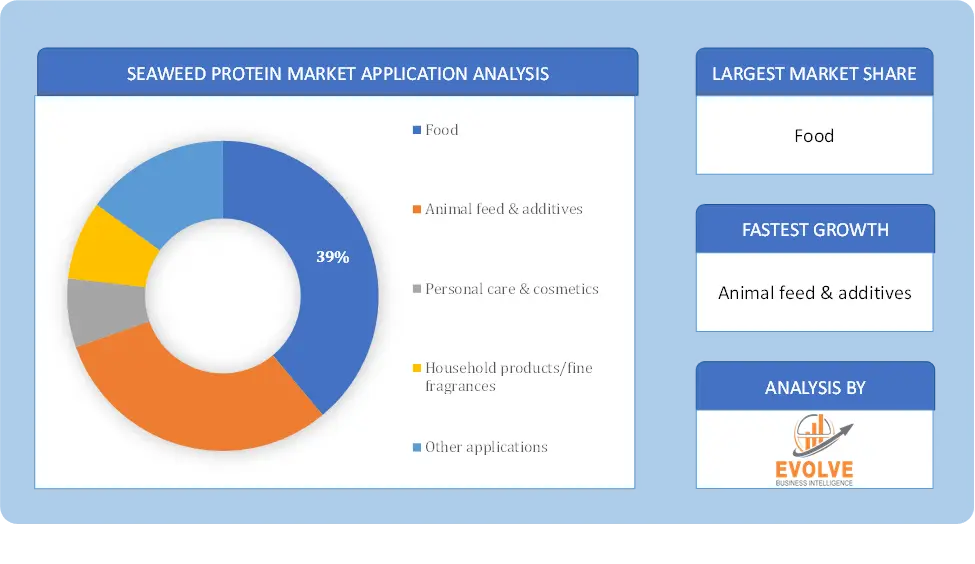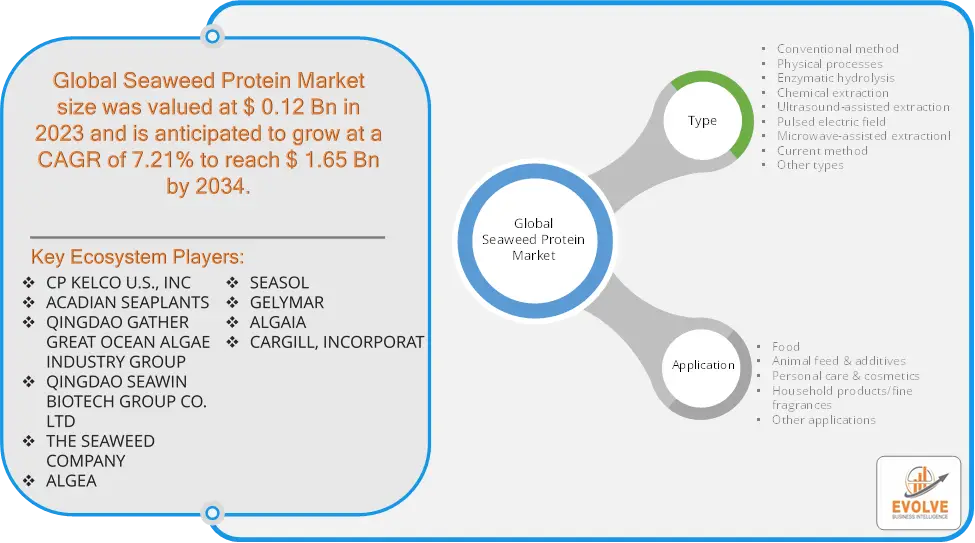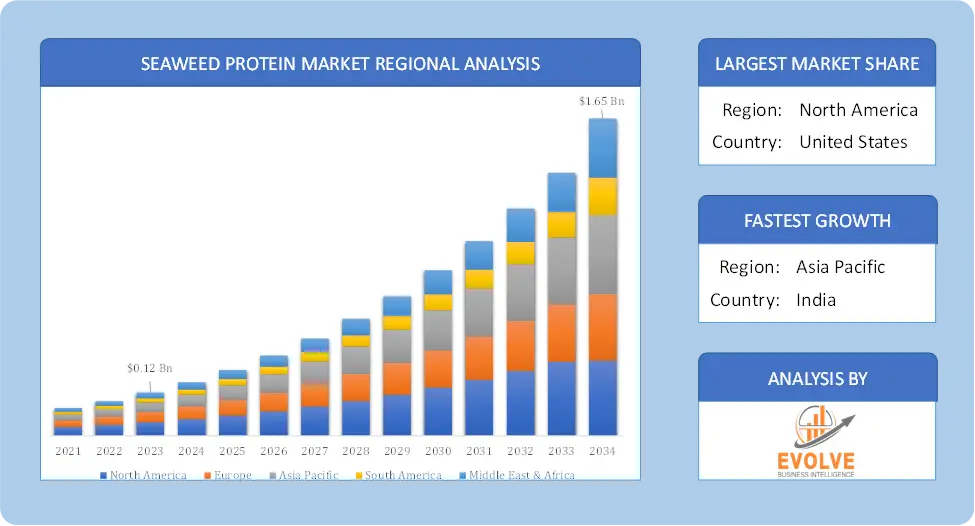Seaweed Protein Market Overview
The Seaweed Protein Market size accounted for USD 0.12 Billion in 2023 and is estimated to account for 0.25 Billion in 2024. The Market is expected to reach USD 1.65 Billion by 2034 growing at a compound annual growth rate (CAGR) of 7.21% from 2024 to 2034. The seaweed protein market focuses on the use of proteins derived from various types of seaweed, which are increasingly recognized for their nutritional benefits and sustainability. Seaweed proteins are a plant-based alternative to traditional animal proteins, offering essential amino acids, vitamins, and minerals. This market is driven by the rising demand for sustainable and plant-based food sources, particularly among health-conscious consumers and those with dietary restrictions. Key applications include food and beverages, dietary supplements, and animal feed. The market is influenced by factors such as growing awareness of the environmental impact of livestock farming, advancements in seaweed cultivation and processing technologies, and increasing investment in research and development. Major regions include Asia-Pacific, Europe, and North America, where consumer interest in alternative proteins is expanding.
Global Seaweed Protein Market Synopsis
 Seaweed Protein Market Dynamics
Seaweed Protein Market Dynamics
The major factors that have impacted the growth of Seaweed Protein are as follows:
Drivers:
Ø Advancements in Seaweed Cultivation and Processing Technologies
Technological improvements in seaweed cultivation, harvesting, and processing have made it easier to scale up production and improve the quality and efficiency of seaweed protein extraction. These advancements contribute to cost reductions and increased availability of seaweed protein in the market.
Restraint:
- High Production Costs
The costs associated with seaweed cultivation, harvesting, and processing can be high, especially for advanced processing technologies and quality control. These costs can be a barrier to the widespread adoption of seaweed protein, making it less competitive compared to other protein sources.
Opportunity:
⮚ Expansion into Emerging Markets
Emerging markets, particularly in Asia-Pacific, Latin America, and Africa, present significant growth opportunities. These regions may offer untapped potential for seaweed protein due to increasing urbanization, changing dietary habits, and growing awareness of plant-based nutrition.
Seaweed Protein Segment Overview
By Type
Based on Type, the market is segmented based on Conventional Method, Physical Processes, Enzymatic Hydrolysis, Chemical Extraction, Current Method, Ultrasound-Assisted Extraction, Pulsed Electric Field, Microwave-Assisted Extraction. the Conventional Method dominates, as it is the most established and widely used technique for extracting seaweed protein, despite the growing interest in more advanced extraction methods.
By Application
 Based on Applications, the market has been divided into the Food, Animal Feed & Additives, Personal Care & Cosmetics, Other Applications. the Food segment dominates, driven by the increasing consumer demand for plant-based protein sources and functional foods. This segment encompasses a wide range of applications, including snacks, beverages, and protein supplements.
Based on Applications, the market has been divided into the Food, Animal Feed & Additives, Personal Care & Cosmetics, Other Applications. the Food segment dominates, driven by the increasing consumer demand for plant-based protein sources and functional foods. This segment encompasses a wide range of applications, including snacks, beverages, and protein supplements.
Global Seaweed Protein Market Regional Analysis
Based on region, the global Seaweed Protein market has been divided into North America, Europe, Asia-Pacific, the Middle East & Africa, and Latin America. Asia-Pacific is projected to dominate the use of the Seaweed Protein market followed by the North America and Europe regions.
 Global Seaweed Protein Asia-Pacific Market
Global Seaweed Protein Asia-Pacific Market
Asia-Pacific holds a dominant position in the Seaweed Protein Market. Due to the existence of extremely populated countries such as China and India, which drive market demand to this area, the Asia-Pacific region holds the highest market share in the global market despite being the fastest-growing region. Another element influencing market demand in this area is a rise in per capita disposable income.
Global Seaweed Protein North America Market
The North America region has indeed emerged as the fastest-growing market for the Seaweed Protein industry. Due to the presence of many significant key players throughout the region that drive market demand over the projected period, the North American region holds the second-largest market share in the worldwide seaweed market. In this region, the primary drivers of market demand are changing lifestyles and rising urbanization.
Competitive Landscape
The global Seaweed Protein market is highly competitive, with numerous players offering a wide range of software solutions. The competitive landscape is characterized by the presence of established companies, as well as emerging startups and niche players. To increase their market position and attract a wide consumer base, the businesses are employing various strategies, such as Type launches, and strategic alliances.
Prominent Players:
- CP KELCO U.S., INC
- ACADIAN SEAPLANTS
- QINGDAO GATHER GREAT OCEAN ALGAE INDUSTRY GROUP
- QINGDAO SEAWIN BIOTECH GROUP CO. LTD
- THE SEAWEED COMPANY
- ALGEA
- SEASOL
- GELYMAR
- ALGAIA
- CARGILL, INCORPORATED
Key Development
Cargill (Minnesota, U.S.) continues its commitment to sustainability. In June 2023, they signed a two-year agreement with CARE International to empower seaweed farmers in Vietnam, particularly women and ethnic minorities.
Scope of the Report
Global Seaweed Protein Market, by Type
- Conventional method
- Physical processes
- Enzymatic hydrolysis
- Chemical extraction
- Ultrasound-assisted extraction
- Pulsed electric field
- Microwave-assisted extractionl
- Current method
- Other types
Global Seaweed Protein Market, by Application
- Food
- Animal feed & additives
- Personal care & cosmetics
- Household products/fine fragrances
- Other applications
Global Seaweed Protein Market, by Region
- North America
- US
- Canada
- Mexico
- Europe
- UK
- Germany
- France
- Italy
- Spain
- Benelux
- Nordic
- Rest of Europe
- Asia Pacific
- China
- Japan
- South Korea
- Indonesia
- Austalia
- Malaysia
- India
- Rest of Asia Pacific
- South America
- Brazil
- Argentina
- Rest of South America
- Middle East & Africa
- Saudi Arabia
- UAE
- Egypt
- South Africa
- Rest of Middle East & Africa
| Parameters | Indicators |
|---|---|
| Market Size | 2033: $1.65 Billion |
| CAGR | 7.21% CAGR (2023-2033) |
| Base year | 2022 |
| Forecast Period | 2023-2033 |
| Historical Data | 2021 |
| Report Coverage | Revenue Forecast, Competitive Landscape, Growth Factors, and Trends |
| Key Segmentations | Type, Application |
| Geographies Covered | North America, Europe, Asia-Pacific, Latin America, Middle East, Africa |
| Key Vendors | CP KELCO U.S., INC, ACADIAN SEAPLANTS, QINGDAO GATHER GREAT OCEAN ALGAE INDUSTRY GROUP, QINGDAO SEAWIN BIOTECH GROUP CO. LTD, THE SEAWEED COMPANY, ALGEA, SEASOL, GELYMAR, ALGAIA, CARGILL, INCORPORATED |
| Key Market Opportunities | • The adoption of artificial intelligence and the internet of things enhances the production of seaweed |
| Key Market Drivers | • A huge increase in demand for natural extracts of food for providing various health benefits |
REPORT CONTENT BRIEF:
- High-level analysis of the current and future Seaweed Protein market trends and opportunities
- Detailed analysis of current market drivers, restraining factors, and opportunities in the future
- Seaweed Protein market historical market size for the year 2022, and forecast from 2021 to 2034
- Seaweed Protein market share analysis at each Type level
- Competitor analysis with detailed insight into its Type segment, Government & Defense strength, and strategies adopted.
- Identifies key strategies adopted including Type launches and developments, mergers and acquisitions, joint ventures, collaborations, and partnerships as well as funding taken and investment done, among others.
- To identify and understand the various factors involved in the global Seaweed Protein market affected by the pandemic
- To provide a detailed insight into the major companies operating in the market. The profiling will include the Government & Defense health of the company’s past 2-3 years with segmental and regional revenue breakup, Type offering, recent developments, SWOT analysis, and key strategies.








